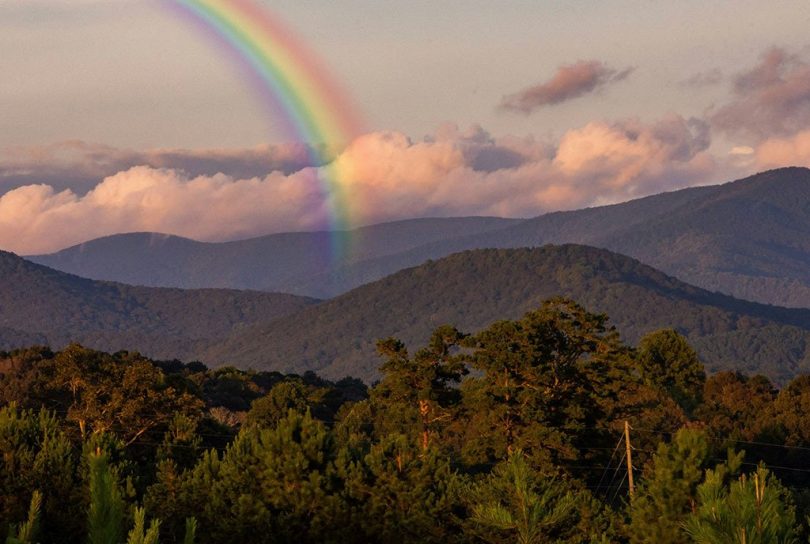Image credit: Abigail Ducote on unsplash.com
Historically, one of the most common arguments for the demonization of LGBTQ people is framing queerness as “against nature.” For example, in 2022, the Texas Republican party said being gay was an “abnormal lifestyle choice,” suggesting that civil rights law that protects LGBTQ people from discrimination should be revoked because of nonnormative sexuality. Similarly, the idea that being cisgender is “normal” while being transgender is not is often invoked to erode transgender rights and access to healthcare.
In this context, the concept of “queer ecologies” emerges as a potent force, seeking to revolutionize human engagement with and perception of the natural world. Through the lens of queer ecology, the exploitative spirit of the “against nature” narrative comes sharply into focus. This framework unveils the marginalization perpetuated by prevailing narratives, thereby empowering queer individuals to (re)connect with nature on their own terms. In fact, queer activists and scholars in Appalachia use this framework as a way to challenge embedded heterophobia and transphobia—and reimagine natural spaces as sites of resistance.
Appalachia is a region ripe for a queer ecological framework. A queer ecological approach to Appalachia would challenge the normative extractive economies and the entangled homophobia in the region. And organizers in the region are already doing work now to create queer ecological futures.
Why Queer Ecologies and Appalachia?
Appalachia is a region that outside interests have repeatedly used for its resources, both cultural and environmental. In tandem with capitalist extraction, it has been culturally marginalized as backward and self-sabotaging.
After the release of US Senator J.D. Vance’s Hillbilly Elegy and the 2016 election of Donald Trump, this has only intensified, with many media pundits dubbing Appalachia as “Trumpalachia.” As described by historian Elizabeth Catte, “Appalachia ceased to be part of America but a destructive force unto its own.”
What Appalachia or Appalachian is depends on who you ask. The Appalachian Regional Commission (ARC) defines the Appalachian region as consisting of 14 states from southern New York to northern Mississippi. According to ARC, 26.3 million people live in Appalachia, about 3 million of whom identify as LGBTQ—7 percent of youth living in a rural region in Appalachia also report a gender identity that does not fully align with the sex they were assigned at birth.
In the Queer Ecologies chapter “Intoxicated Subjects: Queer Bodies and Ecologies in ‘Trumpalachia,’” disability scholar Rebecca Eli Long asserts:
While Appalachian history is replete with descriptions of the region as toxic, these depictions are no less prevalent today. Indeed, Appalachia has been seen as politically toxic, being symbolically the portion of the country that has threatened democracy by electing President Trump. Paradoxically, toxins, associated with death and morbidity, provide a potential framing to reinvigorate static understandings of the Appalachian landscape as a damaged ground for development efforts.
In other words, if Appalachia itself is othered through extractive industries, cultural backwardness, and political populism, what do the queer lives who remain and fight for queer ecological futures mean for the region—and the rest of the United States?
A Queer Ecological Approach
This history of extraction in the region is entangled with the erasure of regional LGBTQ communities, despite a rich queer cultural history.
Research by Rae Garringer, a writer, oral historian, and audio producer, titled The Republic of Fabulachia: Queer Visions for a Post-Coal Appalachian Future, explored how four Appalachian organizers envisioned a just and sustainable future. This included a quote by Kenny Bilbrey, a coordinator for the STAY Project:
I feel like a part of being Appalachian is inevitably queer—whether or not you identify as queer. I think just the whole experience is. Because it’s very self-sufficient in some ways: figuring out your own thing to do if you live in a rural part of Appalachia. Navigating the importance of family and all the other importance that can often be associated with this area—closeness to family or being in love with this bio-diverse place that has a bunch of weird bugs and plants. I just think the whole thing is really queer.
According to Bilbrey, Appalachian queerness is defined by a relationship with nature. It also challenges the notion of queer metronormativity—or the “pervasive assumption that gay and lesbian communities are essentially urban.”
In tandem with the destruction of the Appalachian environment, lawmakers are also attacking LGBTQ rights.
While the historical metronormativity of queer studies has erased the lived experiences of rural LGBTQ people, efforts like Garringer’s podcast Country Queers, the now-defunct Instagram page “Queer Appalachia,” and book series like the University of Kentucky Press’s Appalachian Futures: Black, Native, and Queer Voices, show that LGBTQ Appalachian voices are beginning to be archived and platformed.
In Deviant Hollers: Queering Appalachian Ecologies for a Sustainable Future, an anthology in the Kentucky Press series, scholar-activists consider how the nature-culture dualism has been used to justify oppression. These entangled forms of oppression include patriarchal heteronormativity and colonizing projects. The anthology also explores how disrupting normative understanding of the natural—and people’s relationship to the natural—offers new modes of queer ecological imagining in Appalachia.
“Econormativity is the viewpoint that we, as humans, engage with our environments from a shared perspective or experience,” says Jessica Cory, an English professor at Western Carolina University and contributor to Deviant Hollers. “However, variations between rural/urban, various regions, cultural differences, and disability (among other factors) push back against this idea of econormativity and, really, the idea of ‘normative’ at all regarding the environment more broadly.”
Attacks on LGBTQ Lives
Failing to feel connected to each other and the environment has contributed to the continual exploitation of Appalachian land, air, and water. In tandem with the destruction of the Appalachian environment, lawmakers are also attacking LGBTQ rights.
A few years ago, when we worked on Y’all Means All, we optimistically declared that not only can queer people survive in Appalachia but many of us can and do thrive. Through our endeavors in this project, we unearthed the rich tapestry of queer histories and envisioned utopian queer prospects within the region, striving to construct a dynamic archive of LGBTQ experiences in Appalachia.
“Taking my own biological family and chosen family history as a starting point, Appalachia has always thrived from the contributions of closeted and/or uncloseted LGBTQIA intellectuals, artists, and activists,” filmmaker and Deviant Hollers contributor Chet Pancake says. “In places where geographies are troubled and contested with large-scale timbering, mining, drilling, and industrial accidents, impacted citizens are moved to protect the land and cross all manner of social alliances to attempt to rescue or save a sacred shared, embodied, and ‘felt’ sense of place.”
Discrimination, poverty, and healthcare disparities are entangled with the concept of whose lives matter and whose existence is natural.
Conservative lawmakers in the region have taken aim at this thriving queer community, targeting LGBTQ Appalachians’ access to public life and life-saving healthcare.
In the 2023 legislative session, more than 500 anti-LGBTQ bills were introduced in state legislatures across the country—one in five of which were in Appalachian states. While Appalachian LGBTQ people survive and even thrive, gender-affirming care bans; transgender bathroom bans; diversity, equity and inclusion restrictions; drag bans; and other anti-LGBTQ bills threaten the ability of Appalachian LGBTQ people to exist in public life. When people outside the region say that LGBTQ people do not exist in Appalachia or that Appalachia is inherently an unsafe place for LGBTQ people, they are complicit in these attacks on LGBTQ lives.
There already exists a health and class disparity for LGBTQ people who face compounded harm from extractive industries in Appalachia. Appalachia’s median household income is below the national average, and the poverty rate is 14.5 percent. Meanwhile, 23 percent of LGBTQ people lived in poverty in 2020, and 8 percent of transgender adults experienced homelessness in the past year. One in three transgender adults report an annual household income below $25,000.
Many Appalachians do not have access to healthcare, and the region experiences health disparities, especially regarding cancer and diabetes. The LGBTQ community—particularly transgender people—face medical discrimination when attempting to access healthcare. Nearly half of transgender adults report having negative or discriminatory experiences with a healthcare provider.
A 2020 survey by the Center for American Progress found that 15 percent of LGBTQ people, including one in three transgender people, avoided medical treatment because of discrimination. That discrimination is expected to rise in response to the increase in anti-LGBTQ legislation nationwide. In a 2022 poll by the 19th News, 28 percent of LGBTQ respondents said their healthcare provider was biased or stereotyped them, and 16 percent of LGBTQ respondents said they had been denied medical service.
Discrimination, poverty, and healthcare disparities are entangled with the concept of whose lives matter and whose existence is natural. These inequalities were not only created based on normative ideas of nature but also in tandem with the mass environmental extraction of the region maintained by settler colonialism.
Appalachia as a Sacrifice Zone
In many ways, the Appalachian region has historically been configured as a “sacrifice zone” for capital and settler colonialism. According to sociologist Rebecca Scott in Removing Mountains: Extracting Nature and Identity in the Appalachian Coalfields, a sacrifice zone is a “place that is written off for environmental destruction in the name [of] a higher purpose, such as the national interest.”
“The land is the body and the body is the land.”
Regions that are national sacrifice zones often suffer poverty, as the wealth is transferred outside the region in tandem with environmental degradation, leading to health disparities. In Appalachia, both the region’s human and nonhuman inhabitants have been treated as commodities to be extracted from or abandoned in the pursuit of coal, gas, and profit. While the Appalachian region is home to one of the world’s oldest and most biologically diverse mountain systems, over 300 years of coal extraction has polluted waterways, compromised groundwater, and destroyed 1.5 million acres of forest.
In Remaking Appalachia: Ecosocialism, Ecofeminism, and Law, critical legal scholar Nicholas Stump asserts that the fossil fuel hegemony and other extractive industries have exploited the Appalachian region and its people in the quest for capital accumulation. In other words, capitalism’s “productionist orientation…[has led to] the region’s complex past and contemporary forms of subordination,” both culturally and materially.
Fossil fuel extraction also poses health and safety risks to Appalachian residents and has led to increased rates of illness and a shortened life span. Black lung disease is on the rise, cancer mortality in the Appalachian region is 10 percent higher than the national rate, and infants born to mothers who live near mountaintop removal (MTR) sites, a method of surface coal mining that destroys a mountaintop or ridgeline, have a higher prevalence of birth defects.
MTR has also impacted 500 mountaintops in West Virginia, Kentucky, Virginia, and Tennessee, and an Environmental Protection Agency (EPA) assessment estimated that MTR has buried more miles of stream than the entire length of the Mississippi River. Areas warped by MTR also have a higher likelihood of flooding because the trees that buffer the rain and soil that would soak up water are removed.
“The land is the body and the body is the land,” Pancake says. “Exclusionary and punitive measures by extractive industries to isolate those moved to activism can create a great deal of solidarity among groups who might have appeared to be antagonistic but now find kinship across identity, political stripe, and race and ethnicity.”
This level of environmental degradation, entangled with political and cultural marginalization, has driven queer Appalachian organizers to imagine new ways to engage in queer environmental advocacy efforts.
Moving Toward the Future in Appalachia
As Stump wrote for Yes! Magazine in 2018, “Many Americans elsewhere view Appalachia’s environmental health conditions with ambivalence or outright classist indifference, and some have written us off as a ‘national sacrifice zone.’ But our environmental struggles echo conflicts over the Dakota Access pipeline, the Niger River Delta oil fields, and other places that are trying to limit harms from extractive industries.”
Queer organizers have demanded that extractive industries be dismantled in Appalachia and beyond. Land defenders with the Appalachians Against Pipelines have blocked the Mountain Valley Pipeline (MVP) construction in southwest Virginia by arboreal blockading (tree sitting), locking themselves on equipment, and walking onto active construction sites.
In writing about Yellow Finch, an arboreal blockade site in the patch of the MVP, Pancake says in Deviant Hollers that queer environmental activism in rural areas has grown from the “lesbian movements to purchase and live collectively in peace on communal land.” Yellow Finch centers queer organizers and has been influenced by and has supported other liberatory movements like #NODAPL, Black Lives Matter, the Camp White Pine tree sit, the monopod tree sit on Bent Mountain, and the ongoing struggle for Palestinian liberation.
The queer ecological and anti-colonialist work of Yellow Finch demonstrates that queer thought and community building present paths for a post-extractive future in Appalachia. As Long explains, “Seeing Appalachia as a queer region avoids static, single-issue approaches to regional development that separate the Appalachian landscape from the complexities of nature cultures.”
In other words, Long posits that a queer ecological position demands a refusal of assimilationist and neoliberal politics. Instead of engaging in a greenwashed capitalism, in which the responsibility for environmental damage is artificially pushed onto the individual, despite environmental degradation being enacted by large corporations and complicit governments, queer organizers are demanding a queer type of sustainability that eliminates the roots of extractive industries and oppressive systems.
“As more and more young folks feel the impact of climate change in an embodied way, we have to find productive and collaborative means to address the somatic shock, anxiety, anger, grief, and sadness our youth feel and really see no leadership,” Pancake says. “Space must be created and sustained that supports civil disobedience and validates these ‘symptoms’ as absolutely rational and productive in the face of ecological collapse.”







